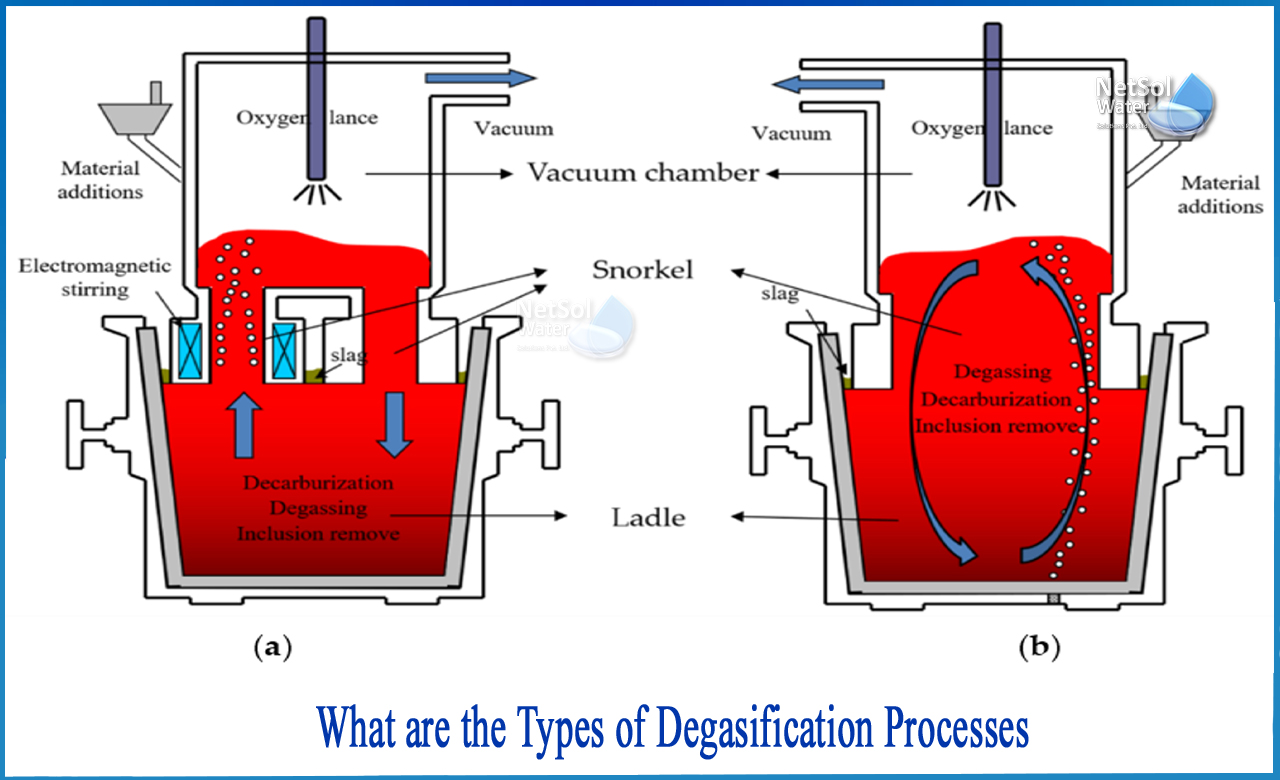What are the types of degasification processes?
Degassing is the technical term for the elimination of problematic, gaseous substances. Because it is linked to a rise in the pH value of the water, deacidification is the technical removal of free, aggressive CO2.
The following are the most common degassing processes:
1- Thermal Degassing
2- Pressure Degassing
3- Vacuum Degassing
4- Membrane Degassing
5- Chemical Degassing
1: Thermal Degassing: Degassing of feedwater to separate out the dissolved and corrosive gases trapped inside necessitates boiling of the water. The solubility of gases in liquids is approaching nil in this condition. Fine distribution using cascading percolation plates serves as a supplement. Degassing can happen when the pressure is too high or too low.
Thermal degassing is an effective method for eliminating dissolved gases from water, particularly boiler feedwater. At the same time, germs are eliminated from the water. Thermal degassing is frequently performed at temperatures slightly over 100 °C and working pressures of 0.2 to 0.3 bar. The feedwater can thus have an oxygen concentration of less than 0.02 mg O2/l and a carbon dioxide content of less than 1 mg CO2/l.
2: Pressure Degassing: occurs when a combination of condensate and fresh water is injected into the top degassing dome. Heating steam enters the degassing unit at the bottom and travels upward against the stream to reach the boiling temperature. The gases emitted as a result are carried away with the exhaust vapours through the exhaust vapour outlet in the degassing dome.In the feedwater tank, the degassed water is collected.
3: Vacuum Degassing: Water can also be degassed below 100 °C using vacuum degassing. By applying a comparable negative pressure (partial vacuum) to the degassing unit, the boiling point can be achieved as early as 30-80 °C.When no hot steam is available for operating thermal pressure degassing, this degassing process is appropriate.
Degassing is done in a percolator equipped with a spraying device, packing section, and supply section. The gases are evacuated with the generated water vapour using a vacuum pump. It is advisable to employ an exhaust vapour condenser in order to keep the vacuum pump's intake volume flow as low as possible. It is also possible to get a residual oxygen content of 0.02 mg/l here. Vacuum degassing is a technique used to purify extra water for heating systems.
4: Membrane Degassing: Membrane degassing removes dissolved carbon dioxide (CO2) from water in pure stripping air mode down to 2 mg/l (ppm) or, in conjunction with a vacuum pump, down to 1 mg/l (ppm). Using industrial nitrogen as the stripping medium and a vacuum pump, oxygen may be reduced to residual levels of 1 g/l (ppb).
Using a corresponding partial pressure gradient as the driving force (stripping with air/gas and/or creating a vacuum), gases diffuse out of the liquid and into the gas-bearing membrane fibres via micro porous, hydrophobic (water-impermeable) hollow-fibre membrane modules, where they are transported away with the stripping gas.
Membrane degassing is a technique used to aid in the desalination process. In the case of ion exchanger demineralization, membrane degassing relieves the burden on the anion exchanger, resulting in a considerable reduction in the demand for regeneration chemicals (mainly sodium hydroxide). This makes membrane degassing a viable alternative to the CO2 percolator, with the added benefit of requiring far less space and energy.
5: Chemical Degassing: Chemical degassing, also known as following degassing, happens as a result of the addition of chemicals. These chemicals dissolve in the dilution water (the quality varies depending on the working circumstances of the steam generator) and are ideal for eliminating or converting the oxygen in the water.The reaction times of the different compounds that can be utilized vary. In general, the higher the temperature of the water, the shorter the response time.
Some of these compounds have essentially no negative effects other than a slight increase in innocuous ions, but others generate free acids that reduce alkalinity. During heating, another group produces steam-volatile alkaline compounds that are effective beyond the boiler to the steam and condensate network.
Netsol Water is Greater Noida-based leading water & wastewater treatment plant manufacturer. We are industry's most demanding company based on client review and work quality. We are known as best commercial RO plant manufacturers, industrial RO plant manufacturer, sewage treatment plant manufacturer, Water Softener Plant Manufacturers and effluent treatment plant manufacturers. Apart from this 24x7 customer support is our USP. Call on +91-9650608473, or write us at enquiry@netsolwater.com for any support, inquiry or product-purchase related query.



